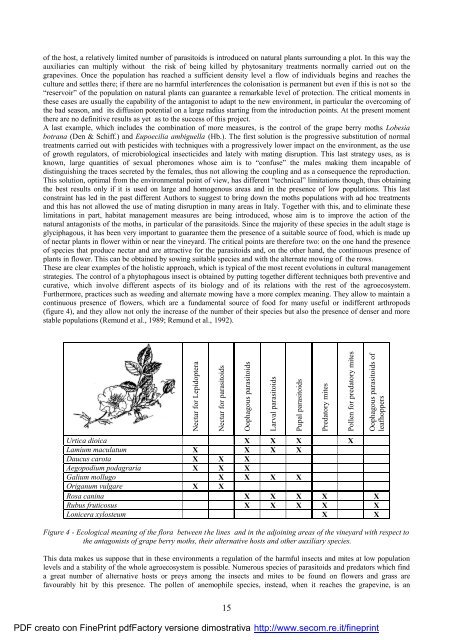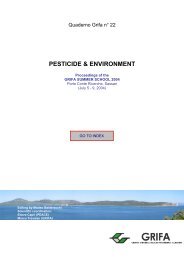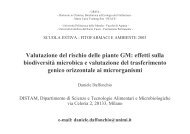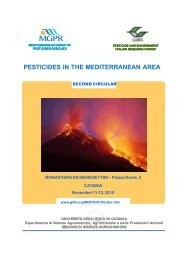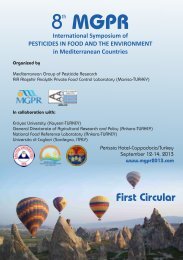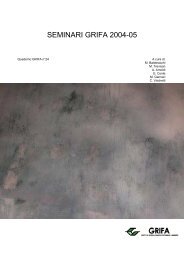International Congress BIOLOGICAL PRODUCTS - Gruppo di ...
International Congress BIOLOGICAL PRODUCTS - Gruppo di ...
International Congress BIOLOGICAL PRODUCTS - Gruppo di ...
Create successful ePaper yourself
Turn your PDF publications into a flip-book with our unique Google optimized e-Paper software.
of the host, a relatively limited number of parasitoids is introduced on natural plants surroun<strong>di</strong>ng a plot. In this way the<br />
auxiliaries can multiply without the risk of being killed by phytosanitary treatments normally carried out on the<br />
grapevines. Once the population has reached a sufficient density level a flow of in<strong>di</strong>viduals begins and reaches the<br />
culture and settles there; if there are no harmful interferences the colonisation is permanent but even if this is not so the<br />
“reservoir” of the population on natural plants can guarantee a remarkable level of protection. The critical moments in<br />
these cases are usually the capability of the antagonist to adapt to the new environment, in particular the overcoming of<br />
the bad season, and its <strong>di</strong>ffusion potential on a large ra<strong>di</strong>us starting from the introduction points. At the present moment<br />
there are no definitive results as yet as to the success of this project.<br />
A last example, which includes the combination of more measures, is the control of the grape berry moths Lobesia<br />
botrana (Den & Schiff.) and Eupoecilia ambiguella (Hb.). The first solution is the progressive substitution of normal<br />
treatments carried out with pesticides with techniques with a progressively lower impact on the environment, as the use<br />
of growth regulators, of microbiological insecticides and lately with mating <strong>di</strong>sruption. This last strategy uses, as is<br />
known, large quantities of sexual pheromones whose aim is to “confuse” the males making them incapable of<br />
<strong>di</strong>stinguishing the traces secreted by the females, thus not allowing the coupling and as a consequence the reproduction.<br />
This solution, optimal from the environmental point of view, has <strong>di</strong>fferent “technical” limitations though, thus obtaining<br />
the best results only if it is used on large and homogenous areas and in the presence of low populations. This last<br />
constraint has led in the past <strong>di</strong>fferent Authors to suggest to bring down the moths populations with ad hoc treatments<br />
and this has not allowed the use of mating <strong>di</strong>sruption in many areas in Italy. Together with this, and to eliminate these<br />
limitations in part, habitat management measures are being introduced, whose aim is to improve the action of the<br />
natural antagonists of the moths, in particular of the parasitoids. Since the majority of these species in the adult stage is<br />
glyciphagous, it has been very important to guarantee them the presence of a suitable source of food, which is made up<br />
of nectar plants in flower within or near the vineyard. The critical points are therefore two: on the one hand the presence<br />
of species that produce nectar and are attractive for the parasitoids and, on the other hand, the continuous presence of<br />
plants in flower. This can be obtained by sowing suitable species and with the alternate mowing of the rows.<br />
These are clear examples of the holistic approach, which is typical of the most recent evolutions in cultural management<br />
strategies. The control of a phytophagous insect is obtained by putting together <strong>di</strong>fferent techniques both preventive and<br />
curative, which involve <strong>di</strong>fferent aspects of its biology and of its relations with the rest of the agroecosystem.<br />
Furthermore, practices such as wee<strong>di</strong>ng and alternate mowing have a more complex meaning. They allow to maintain a<br />
continuous presence of flowers, which are a fundamental source of food for many useful or in<strong>di</strong>fferent arthropods<br />
(figure 4), and they allow not only the increase of the number of their species but also the presence of denser and more<br />
stable populations (Remund et al., 1989; Remund et al., 1992).<br />
Nectar for Lepidoptera<br />
Nectar for parasitoids<br />
Urtica <strong>di</strong>oica X X X X<br />
Lamium maculatum X X X X<br />
Daucus carota X X X<br />
Aegopo<strong>di</strong>um podagraria X X X<br />
Galium mollugo X X X X<br />
Origanum vulgare X X<br />
Rosa canina X X X X X<br />
Rubus fruticosus X X X X X<br />
Lonicera xylosteum X X<br />
Figure 4 - Ecological meaning of the flora between the lines and in the adjoining areas of the vineyard with respect to<br />
the antagonists of grape berry moths, their alternative hosts and other auxiliary species.<br />
This data makes us suppose that in these environments a regulation of the harmful insects and mites at low population<br />
levels and a stability of the whole agroecosystem is possible. Numerous species of parasitoids and predators which find<br />
a great number of alternative hosts or preys among the insects and mites to be found on flowers and grass are<br />
favourably hit by this presence. The pollen of anemophile species, instead, when it reaches the grapevine, is an<br />
PDF creato con FinePrint pdfFactory versione <strong>di</strong>mostrativa http://www.secom.re.it/fineprint<br />
15<br />
Oophagous parasitoids<br />
Larval parasitoids<br />
Pupal parasitoids<br />
Predatory mites<br />
Pollen for predatory mites<br />
Oophagous parasitoids of<br />
leafhoppers


